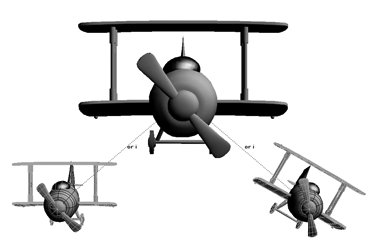You can constrain the rotation values of one or more selected objects to another object without changing the location of the constrained objects. A rotation performed on the constraining object is also performed on the constrained objects.
For example, you can make a group of people's heads all move in sync by animating one head and then constraining the rotation of all the others to this head. Or for a character's arms, which usually have their bones rotated, you can orient-constrain your rig's bones to another's.


On the top, two small planes are constrained by orientation to the large plane. The small plane in the lower right has been offset by 30û.
On the bottom, when the large plane rotates, the small planes rotate by the same amount as well.
To constrain an object's orientation
Choose Constrain  Orientation and pick the object that is to act as a constraint.
Orientation and pick the object that is to act as a constraint.
In the Orientation constraint property editor, you can set a Rotation Offset between the centers of the constrained and constraining objects by entering X, Y, and Z values in degrees. See Creating Offsets between Constrained and Constraining Objects for more information.
Select the constraining object and rotate it as desired. The constrained objects also rotate.
You can also set rotation limits for an inverse kinematic (IK) chain in its Kinematic Joint property editor — see Setting Rotation Limits [Character Animation].